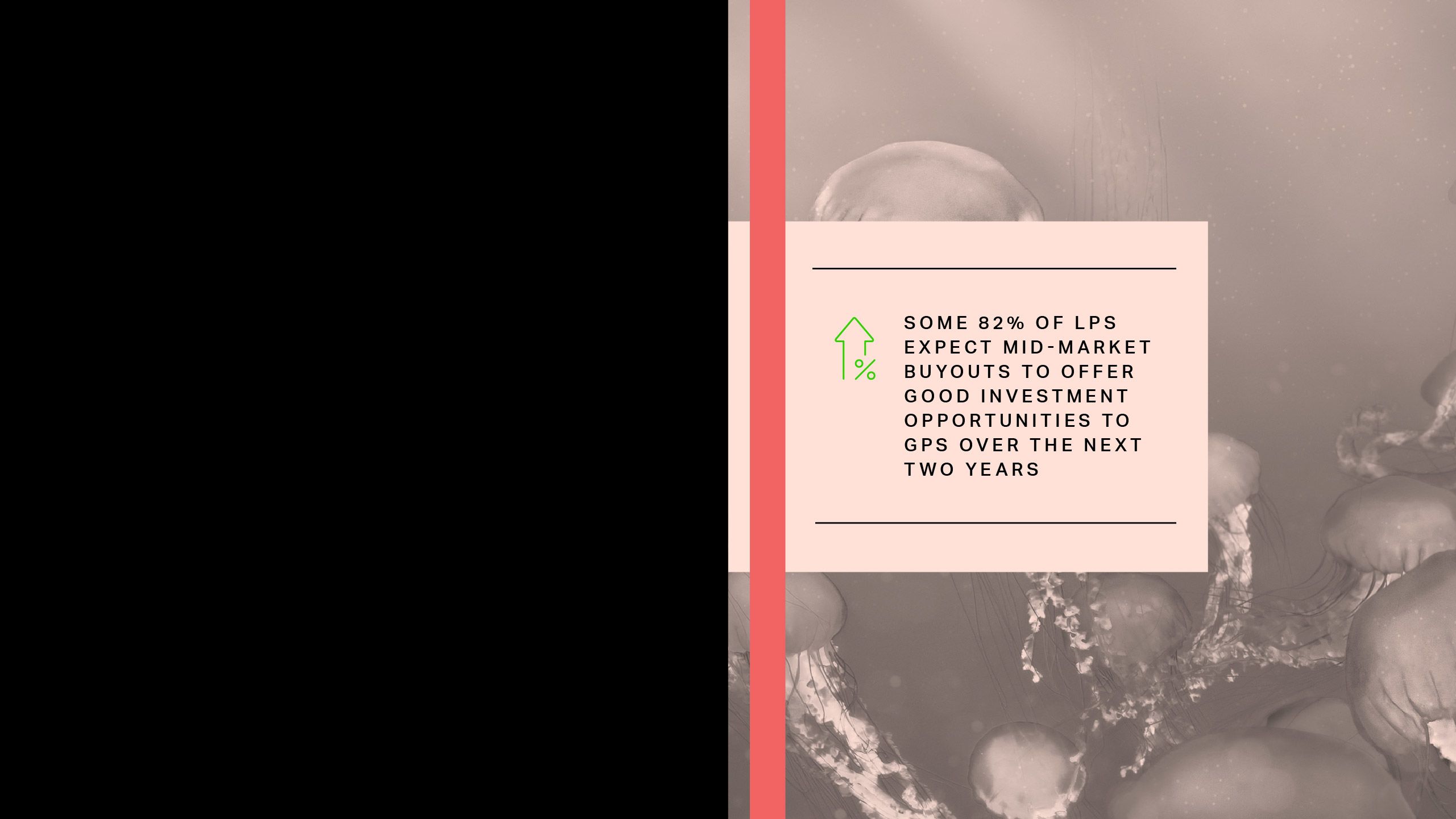Where Do We Go From Here?
2024 Predictions for Private Funds
in Light of 2023 Trends

Where Do We Go From Here?
2024 Predictions for
Private Equity in Light
of 2023 Trends

Capital flowed freely in private markets for well over a decade. Realizations were rampant and successive funds were routinely ramped up in size. However, the industry was hit hard by a confluence of geopolitical and macroeconomic headwinds in 2023. Pervasive uncertainty around everything from monetary policy to global conflict led to a substantial contraction in traditional exit opportunities1. For investors (LPs), the dearth of distributions was compounded by a denominator effect caused by a drop in public markets. The result was a difficult year for many private fund sponsors (GPs) on the fundraising trail.
The value of global alternative funds raised was down by 21% to $972bn in the first 10 months of 20232. In the third quarter of last year, there were close to 14,000 funds in the market seeking an aggregate $3.3tn in commitments, against approximately $1tn in available LP allocations3.
However, as we leave 2023 behind us, there is light emerging at the end of the tunnel. The denominator effect has eased meaningfully. Listed assets have rebounded, and global equities are now close to where they were at the market peak. Exit activity also appears to be cautiously resuming, with the total number of global private equity exits in Q3 2023 up almost 22% on the same period 12 months earlier4.
In addition, from secondaries to private credit, there are pockets of private markets that are demonstrably thriving, and the asset class as a whole has once again shown its ingenuity and creativity in the face of adversity.

In this article, we reflect on the challenges the industry faced in 2023 and predict where 2023’s trends will head in 2024.


The value of global alternative funds raised was down by 21% to $972bn in the first 10 months of 20232. In the third quarter of last year, there were close to 14,000 funds in the market seeking an aggregate $3.3tn in commitments, against approximately $1tn in available LP allocations3.
However, as we leave 2023 behind us, there is light emerging at the end of the tunnel. The denominator effect has eased meaningfully. Listed assets have rebounded, and global equities are now close to where they were at the market peak. Exit activity also appears to be cautiously resuming, with the total number of global private equity exits in Q3 2023 up almost 22% on the same period 12 months earlier4.
In addition, from secondaries to private credit, there are pockets of private markets that are demonstrably thriving, and the asset class as a whole has once again shown its ingenuity and creativity in the face of adversity.

In this article, we reflect on the challenges the industry faced in 2023 and predict where 2023’s trends will head in 2024.


Credit Where Credit’s Due
While increased interest rates have impacted private equity’s ability to generate returns through the use of leverage, the macroeconomic environment in 2023 created opportunities elsewhere in the capital stack.
Private credit had a strong year
in 2023, attracting $147.2bn
in commitments over the
first three quarters

Private credit had a strong year in 2023, attracting $147.2bn in commitments over the first three quarters

As banks retrenched, private lenders saw a surge in opportunities. Funds investing in floating rate instruments, meanwhile, benefitted from yields that rose with the interest rate tide. As a result, private credit had a strong year in 2023, attracting $147.2bn in commitments over the first three quarters of the year5. LP sentiment toward private credit was overwhelmingly positive in 2023, with 90% of LPs stating in a second quarter survey that the asset class had met or exceeded their expectations6.
While direct lending dominated private credit fundraising, we saw mezzanine rapidly catching up, not least because of the payment-in-kind feature that allows borrowers to conserve cash in difficult times. Special situations are also taking an increasingly significant share of the growing private credit fundraising pie. As a result, we expect that private credit’s momentum will carry over into 2024, at least for as long as interest rates remain elevated relative to recent history.
As banks retrenched, private lenders saw a surge in opportunities. Funds investing in floating rate instruments, meanwhile, benefitted from yields that rose with the interest rate tide. As a result, private credit had a strong year in 2023, attracting $147.2bn in commitments over the first three quarters of the year5. LP sentiment toward private credit was overwhelmingly positive in 2023, with 90% of LPs stating in a second quarter survey that the asset class had met or exceeded their expectations6.
While direct lending dominated private credit fundraising, we saw mezzanine rapidly catching up, not least because of the payment-in-kind feature that allows borrowers to conserve cash in difficult times. Special situations are also taking an increasingly significant share of the growing private credit fundraising pie. As a result, we expect that private credit’s momentum will carry over into 2024, at least for as long as interest rates remain elevated relative to recent history.


Spotlight on Secondaries
The secondaries industry drew big crowds in 2023, an ongoing trend discussed in the Spring 2023 and Summer 2023 editions of this Bulletin7. Although secondaries also felt the crunch in terms of number of funds raised in 2023, the funds that did close were multiples bigger. Secondaries fundraising in the first nine months of 2023 surpassed annual fundraising totals for every calendar year except 2020, hitting $68.1bn across 39 funds. By comparison, in all of 2022, 113 funds raised a total of $57.6bn8. And there is little sign that the sector’s fundraising momentum, and concentration, is slowing, with several mega secondaries funds still in market.
Deal volumes did not initially keep pace with investor enthusiasm in 2023. Activity fell by around 25% year-on-year in the first six months of last year due to pricing gaps9. A rebound in public markets during the second half of 2023 contributed to valuations of LP-led portfolios in most asset classes rebounding enough to narrow the pricing mismatch between sellers and buyers, resulting in an uptick in transaction volume. The fundamentals around LP-led secondaries also remain attractive given ongoing liquidity pressures, as distributions remain relatively thin on the ground as compared to recent years.
The GP-led market is showing signs of revival as well, having also slowed slightly in the first half of 2023 due to pricing mismatches. However, the quantity and quality of continuation vehicles coming to market as GPs look to generate liquidity for their LPs ahead of future fundraising means GP-led transaction volume is also likely to pick up in 2024.

We expect that the secondaries industry will continue its upward march in 2024, in terms of both fundraising and deal volume, with increased specialization of strategy as the sector matures. We also anticipate that, despite 2023’s fundraising concentration, the growth of this sector will continue to attract new entrants.


Spotlight on Secondaries
The secondaries industry drew big crowds in 2023, an ongoing trend discussed in the Spring 2023 and Summer 2023 editions of this Bulletin7. Although secondaries also felt the crunch in terms of number of funds raised in 2023, the funds that did close were multiples bigger. Secondaries fundraising in the first nine months of 2023 surpassed annual fundraising totals for every calendar year except 2020, hitting $68.1bn across 39 funds. By comparison, in all of 2022, 113 funds raised a total of $57.6bn8. And there is little sign that the sector’s fundraising momentum, and concentration, is slowing, with several mega secondaries funds still in market.
Deal volumes did not initially keep pace with investor enthusiasm in 2023. Activity fell by around 25% year-on-year in the first six months of last year due to pricing gaps9. A rebound in public markets during the second half of 2023 contributed to valuations of LP-led portfolios in most asset classes rebounding enough to narrow the pricing mismatch between sellers and buyers, resulting in an uptick in transaction volume. The fundamentals around LP-led secondaries also remain attractive given ongoing liquidity pressures, as distributions remain relatively thin on the ground as compared to recent years.
The GP-led market is showing signs of revival as well, having also slowed slightly in the first half of 2023 due to pricing mismatches. However, the quantity and quality of continuation vehicles coming to market as GPs look to generate liquidity for their LPs ahead of future fundraising means GP-led transaction volume is also likely to pick up in 2024.

We expect that the secondaries industry will continue its upward march in 2024, in terms of both fundraising and deal volume, with increased specialization of strategy as the sector matures. We also anticipate that, despite 2023’s fundraising concentration, the growth of this sector will continue to attract new entrants.
Ending the Liquidity Drought, by New Methods or Old
Secondaries were not the only mechanism for generating liquidity that GPs turned to in 2023. NAV loans, or at least the flexibility to utilize NAV loans, became increasingly popular, both to fuel growth strategies and to accelerate distributions to investors. Other mechanisms, such as preferred equity and collateralized fund obligations, also saw an uptick in interest.
As examined in the Autumn edition of this Bulletin, the curiosity toward NAV finance and other liquidity mechanisms is likely to remain a focal point into 2024, at least until the M&A and IPO markets see further thawing10.
Mega Meets Mid-Market
Mega funds faced conflicting trends in 2023. While there were some undeniably impressive mega fund closes over the past year, other mega funds dialed back expectations, in some cases substantially below amounts raised by predecessor funds. 2023 saw LPs continuing to flock to their tried and trusted GPs, in some instances actively reducing the number of their GP relationships.
At the same time, however, 2023 saw the mid-market coming into its own. As high interest rates curbed the potential for leverage, the mid-market garnered increasing attention as a sector with great potential for value creation. And LPs took note. Some 82% of LPs expect mid-market buyouts to offer good investment opportunities to GPs over the next two years11. Unsurprisingly, LPs are planning to increase their exposure to the sector, with 38% looking to do so with respect to the mid-market and 42% with respect to the lower mid-market12.
The convergence of these trends could well lead to a continued theme in 2024: mega managers launching mid-market funds. These products offer LPs the ability to consolidate with their most valued relationships, while also gaining access to potentially higher returning mid-market opportunities.


Mega Meets Mid-Market
Mega funds faced conflicting trends in 2023. While there were some undeniably impressive mega fund closes over the past year, other mega funds dialed back expectations, in some cases substantially below amounts raised by predecessor funds. 2023 saw LPs continuing to flock to their tried and trusted GPs, in some instances actively reducing the number of their GP relationships.
At the same time, however, 2023 saw the mid-market coming into its own. As high interest rates curbed the potential for leverage, the mid-market garnered increasing attention as a sector with great potential for value creation. And LPs took note. Some 82% of LPs expect mid-market buyouts to offer good investment opportunities to GPs over the next two years11. Unsurprisingly, LPs are planning to increase their exposure to the sector, with 38% looking to do so with respect to the mid-market and 42% with respect to the lower mid-market12.
The convergence of these trends could well lead to a continued theme in 2024: mega managers launching mid-market funds. These products offer LPs the ability to consolidate with their most valued relationships, while also gaining access to potentially higher returning mid-market opportunities.


Choppy Waters for Infrastructure
Infrastructure is another asset class that should be a net beneficiary of the current economic backdrop. Assets that provide essential services to society are inherently decorrelated to GDP. Crucially, many also offer positive inflation linkage.
Dip is Likely to Be Temporary
Infrastructure’s fundraising dip is likely to be temporary, given its offer of stability and predictability in unstable and unpredictable times

Dip is Likely to
Be temporary
Infrastructure’s fundraising dip is likely to be temporary, given its offer of stability and predictability in unstable and unpredictable times

Infrastructure, however, was not immune to fundraising pressures in 2023. Not only were LPs dealing with the denominator effect and the liquidity constraints caused by delayed exits, but some also chose to revert to fixed income strategies as an alternative to core infrastructure in a higher interest rate environment. After receiving a bump from the U.S. Inflation Reduction Act in 2022, infrastructure fundraising came back down to earth in 2023, with 54 funds raising approximately $20bn in the first three quarters of 2023, compared to 110 funds raising approximately $139bn in the same period in 202213.
But as discussed in the Autumn 2023 edition of this Bulletin, infrastructure’s fundraising dip is likely to be temporary, given the asset class’s offer of stability and predictability in unstable and unpredictable times14. Furthermore, infrastructure investment is bolstered by two of the greatest mega-trends of this generation – the energy transition and digital transformation. Reinforced by unprecedented regulatory support, we anticipate continued demand for infrastructure capital through 2024 and beyond.
Bracing for Impact
The bourgeoning world of ESG and impact investing faced macroeconomic and political obstacles in 2023. In the Summer 2023 edition of this Bulletin, we looked in depth at the surge in ESG backlash in the U.S., which created additional hurdles for many U.S. focused ESG and impact funds15. According to a recent survey, LPs in North America showed dropping levels of confidence in the potential of ESG in 2023, with just 41% saying a strong ESG policy can improve long-term financial returns16. In contrast, 60% of respondents in the Asia-Pacific region and 79% of respondents in Western Europe agreed that a focus on ESG improves long-term returns. Another potential factor for subdued 2023 ESG/impact fundraising may be the relative youth of many GPs in the space, a significant hurdle at a time when LPs are placing a premium on longevity.

After record years in 2021 and 2022, just $8.3bn was raised for ESG/impact funds in the first three quarters of 202317. Those numbers will get a boost in the fourth quarter of 2023 from some of the biggest GPs in the space, with KKR recently closing its second global impact fund, TPG closing its third Rise fund and Brookfield receiving initial commitments for its second global transition fund.
Our prediction is that despite political polarization in the U.S. surrounding the ESG and impact labels, sustainable investing is here to stay. We anticipate that GPs with an established track record and compelling strategy will continue to see demand for ESG and impact products, under any label.


The Middle East Takes Center Stage
Geopolitical tensions intensified throughout 2023. With conflicts ongoing in Europe and the Middle East and continued frosty relations between the U.S. and China, there were inevitable consequences for global capital flows last year. However, in 2023 we also saw the Middle East proving to be a persuasive proposition, with a number of GPs recently opening offices in the Gulf as they seek to strengthen relationships with the region’s sovereign wealth funds. GPs are also keen to explore opportunities to invest in the region’s transition towards a post-oil future, a trend that we expect to continue in 2024.
Private equity is not yet out of the macro woods. If the trends discussed above continue, however, we expect a robust 2024 for the industry – in terms of both traditional dealmaking and fundraising, as well as continued innovation with respect to strategies and financing solutions.
